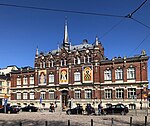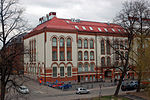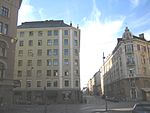Ullanlinna

Ullanlinna (Finnish: [ˈulːɑŋˌlinːɑ]; Swedish: Ulrikasborg) is a city district of Helsinki, in Finland. The name Ullanlinna (English: "Ulla's Castle") refers to the fortification line that was built at the southern edge of the area during the 18th century (no longer visible), as part of the town fortifications, which also included the fortress of Suomenlinna. The name Ulla refers to the Swedish Queen Ulrika Eleonora (1688–1741). During the 19th century the area was dominated by summer pavilions owned by the wealthy Helsinki middle-classes. The appearance of the area changed gradually at the end of the 19th century as the wooden houses were replaced with much higher stone buildings, designed in the prevailing Jugendstil architectural style synonymous with National Romanticism.The central part of Ullanlinna is marked by the Tähtitorninpuisto park (English: Observatory Park), at the centre of which is the former observatory, designed by Carl Ludvig Engel in 1825 in the Neoclassical style of architecture. Other notable buildings in the district are the Design Museum and the Museum of Finnish Architecture.
Excerpt from the Wikipedia article Ullanlinna (License: CC BY-SA 3.0, Authors, Images).Ullanlinna
Tehtaankatu, Helsinki Ullanlinna (Southern major district)
Geographical coordinates (GPS) Address Nearby Places Show on map
Geographical coordinates (GPS)
| Latitude | Longitude |
|---|---|
| N 60.158333333333 ° | E 24.947222222222 ° |
Address
Tehtaankatu
00140 Helsinki, Ullanlinna (Southern major district)
Finland
Open on Google Maps











